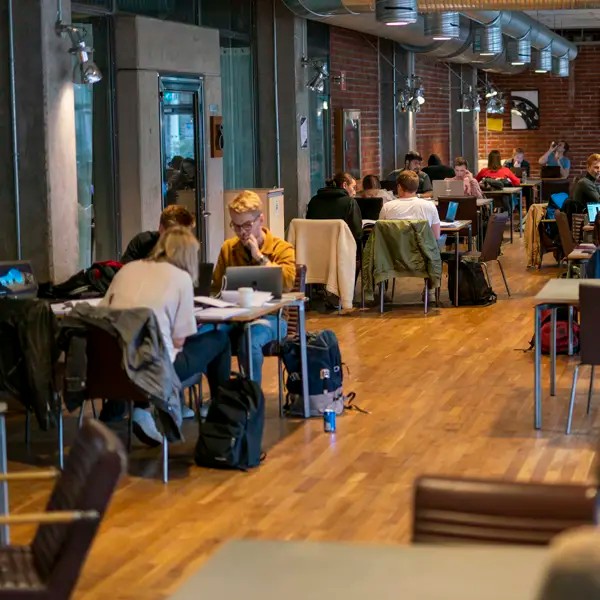
From our careers and social lives to shopping and entertainment, human life increasingly takes place online, mediated through digital applications and services. As interactions between humans and machines become ever more deeply embedded in our daily lives, they need to be refined, improved, and made as effective as possible.
This master’s programme will give you the opportunity to play a vital part in building the next generation of applications, which may come to define how we live and work in the coming decades.
Interaction design and technologies, master's programme at Chalmers
More and more of human life is going to take place online with digital applications – from professional collaboration and shopping to staying in touch with friends and entertainment. This programme will give you the opportunity to play a vital part in building all these application services.
The collaboration between humans and machines needs to be even more efficient and effective in the future, therefore the interface needs to have a high degree of usability. It is no longer enough to build a system, product or application that is only functional or efficient; there is an increasing demand for products that are not only efficient but also consider human factors, such as being ethical, sustainable, accessible, as well as pleasurable to handle and use or even fun or intriguing. The experience might also be challenging, frustrating, and provocative, for example when you design a computer game. Therefore, interaction designers will often work on designing the user experience.
The master's programme is intended for anyone with a keen interest in the interaction between humans and technology. This means that the programme attracts students from different educational backgrounds – from computer science and software engineering to design (in its many forms) and cognitive science.
The technology we work with in the programme is well-established such as desktop computers and smartphones, but also new and innovative technologies such as dialogue interfaces, robots, virtual agents and virtual reality. You will train to be highly skilled in building today's interfaces, but also be prepared to take part in the development of future ways of interacting with computers. The majority of the projects our students work with are software-based, but there is also a number of courses and projects that involve tangible interfaces and physical prototypes built in our maker space design studio. During your time in this programme, you will work with many different creative tools, everything from post-its, cardboard and wood to electronics, 3D printers and laser cutters.
We have several game-development-related courses, led by prominent researchers in the field. There are good opportunities for game-interested students to collaborate with game companies or with other students who study game design at Gothenburg university.
It feels great collaborating with others and seeing the problems from various angles, knowing that there is always room for improvement

Topics covered
The subjects of design, technology, ethics, and user behaviour are fundamental areas in the Interaction design and technologies master’s programme. The courses included in the programme plan handle topics such as design processes and prototyping, human-centred design, interactive simulations, visualization, interactive art, and game development.
Career
As an interaction designer, you can work in any industry and any company or other organization that develops digital applications, systems, or machines that interact with a human. Interaction designers can be found in any software company, as well as in the game industry, or in companies that combine hardware and software in products such as cars, kitchen equipment and smartphones. Other key areas include web design, information visualization, artistic applications such as interactive installations and live performances, and design of online services such as webshops and online banking.
Large companies such as Volvo, ABB, Google, and Microsoft are of course a place where you often find interaction designers (or UX designers which is a popular title at the moment), but you can also find work at non-profit organizations or governmental institutions. Other potential employers are start-up companies or smaller companies developing new and innovative solutions, for example in the gaming industry or in virtual reality providers. You can also work as an engineer and designer in interactive art projects and performances.
Research
The programme is offered by the Division of Interaction design at the Department of Computer science and engineering at Chalmers. The teachers are also researchers, working in areas such as tangible interaction, game design, innovative user interfaces, artificial intelligence for music and arts, virtual reality and the use of IT in vehicles.
Here are some examples of our many research projects:
- Social drones – How can humans and airborne drones co-exist, and communicate with each other?
- VR for learning about air quality – In the CityAirSim project we have developed new methods to calculate how vegetation affects air quality in the city streets, and then we visualize the result in virtual reality to teach students how to plan for future cities.
- Artistic research – Machine learning and artificial intelligence for music and arts.
Both in our research and our teaching with have close collaboration with industry and other organizations in society, ranging from small local start-up companies to large companies such as Volvo and ABB. We often bring in our alumni or other professionals as guest lecturers or guest critics, and both in the master thesis project and other project courses the students work with companies acting as external clients. It is also common for our students to collaborate with other organizations that play very important roles in our society, such as Amnesty or the Swedish children's rights organisation Bris.
Find out more about research in Computer science and engineering
Requirements

How to apply - From application to admission
This is a step-by-step guide on how to apply for a Master's programme at Chalmers University of Technology.

